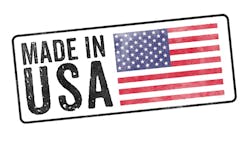The Trump administration has identified reindustrialization as an economic priority and is betting on a mix of tax reform, deregulation and a heavy tariff hand to achieve it. One of those tools, the tariffs, regularly comes under lots of criticism. But the criticism often extends to the effort itself. Because, the detractors ask, who wants to work in a factory anyway?
“You’re sitting on a line, assembling things, like Laverne and Shirley putting bottle caps on bottles,” said the CEO of a California toy company that imports its products. “Do most Americans want to sew tiny little skirts a thousand times a day?”
Naysayers often claim a reversal of domestic manufacturing’s fortunes can’t and won’t work and, further, that we don’t need to care. But it takes a selective understanding of our industrial history to arrive at this conclusion. Manufacturing still very much matters.
Consider first the argument made by the toy executive; that no one wants this work. A poll produced by the libertarian Cato Institute was interpreted that way, finding 80% of respondents think the U.S. would be better off if more Americans worked in manufacturing, but only 25% think they would personally be better off if they were doing it.
This was taken up by many as proof that Americans don’t want factory jobs – a reading that assigns a cynicism to the politics of those in the gap between the points. But in its historical context, a different picture emerges: 19 million Americans, or 22% of the entire workforce, worked in manufacturing when jobs in the sector peaked in 1979.
So let’s take the Cato survey at its word; that 25% of those polled say a factory job would benefit them. There are roughly 12.5 million manufacturing workers in the United States right now – about 8% of the workforce. If employment matched demand, we would have a pool of more than 36 million manufacturing workers. And if that’s the case, we should be changing the “college or bust” mindset by rapidly expanding training pipelines so that more of us can pursue these kinds of careers.
What about the argument that disappearing factories are a normal part of economic development? It’s true that not every country needs to maintain manufacturing capacity for every input or product.
But this inevitability critique is also made without context. U.S. industrial decline has been swifter and deeper than many of its comparable precedents and, considering the size of our economy and consumption, we punch below our manufacturing weight. What’s more: While other sectors obviously occupy healthy shares of U.S. GDP, that doesn’t mean manufacturing must zero out or that its decline isn’t a problem. Much of it has been simultaneous with China’s industrial rise; a reversal that has created dangerous dependencies for products and inputs with both commercial and military applications. China now controls more than a third of global manufacturing, and in some critical sectors like shipbuilding, electric vehicles, rare earth minerals and processing, has begun to monopolize production.
Finally, there is the reliable contention that automation will ultimately swamp factory floors; that it’s a fool’s game to localize manufacturing because we’re on the verge of replacing all the workers with robots.
This is a mistake, as well. If the argument is about political support, suggesting that more deindustrialization will resonate with voters is what’s actually foolish.
But the misreading is deeper than that. The automation argument ignores that manufacturing productivity rates have been improving since before the invention of the loom. U.S. manufacturing employment cycles have been shaped mostly by China’s rise and periods of economic recession or growth. For instance, why did factory jobs stabilize in the late 1990s, swiftly decline in the 2000s, and then grow again through most of the 2010s? It’s not like robots took a decade off.
It’s true that automation places a ceiling on manufacturing growth, but we’re nowhere close to reaching that theoretical height. If you’ve peeked inside a large-scale factory, you’ll see lots of automation, and also hundreds if not thousands of skilled workers manipulating, programming, installing and servicing the operations.
This is part of the draw. Potential workers are no longer being asked to enter the mind-numbing sweatshops of previous industrial generations, as that toy executive describes them; they’re being presented with career paths that are dynamic and on the cutting edge.
The repetition is left to the robots. More manufacturing, automated or not, begets innovation, invention and more manufacturing. That means more work.
And that’s why factories are coveted: The economic development they bring is why at both national and global levels we’re awash in industrial policies trying to induce it. It’s why the Trump administration is pursuing it too, although it’s leaving valuable tools on the table. Its current efforts, framed around tariffs, should be paired with the steady public investment needed to create an environment that manufacturing thrives in. Factory construction boomed in response to industrial policies and the aftermath of recent supply chain shocks. There’s no reason why that can’t be sustained.
The administration would be wise to come to a conclusion on tariffs that provides certainty to potential investors and expand successful policies to draw in key industries. Because, despite what the critics say, we need manufacturing in this country. From the Arsenal of Democracy decades ago to supplying critical goods during a recent pandemic, we’ve leaned on our capacity to manufacture in the past. There will come a time when we’ll need to lean on it again.
About the Author

Scott Paul
President, Alliance for American Manufacturing
Scott Paul is president of the Alliance for American Manufacturing (AAM), a partnership established in 2007 by some of America’s leading manufacturers and the United Steelworkers union. Scott and AAM have worked to make American manufacturing and “Made in America” top-of-mind concerns for voters and our national leaders through effective advocacy, policy development, and data-driven research.
